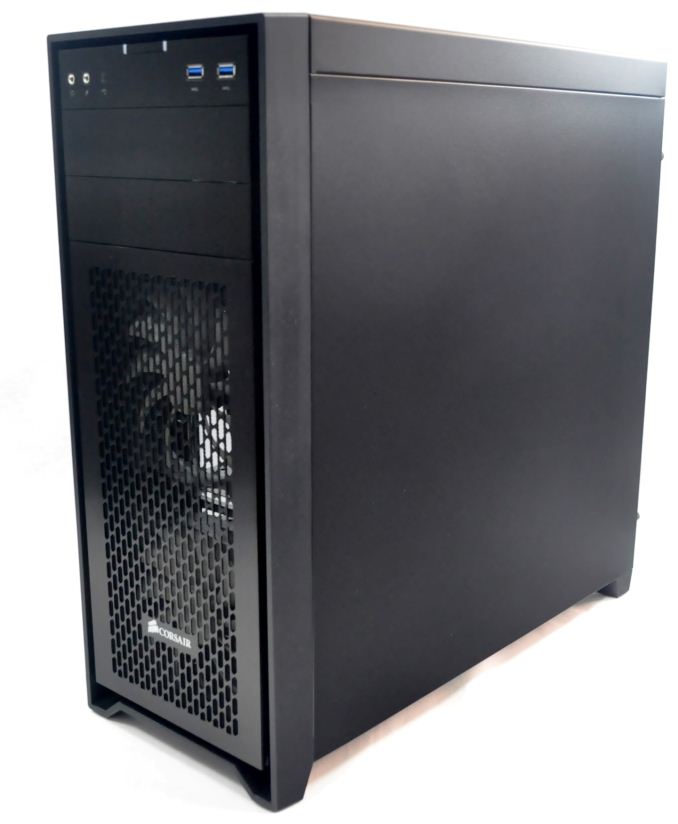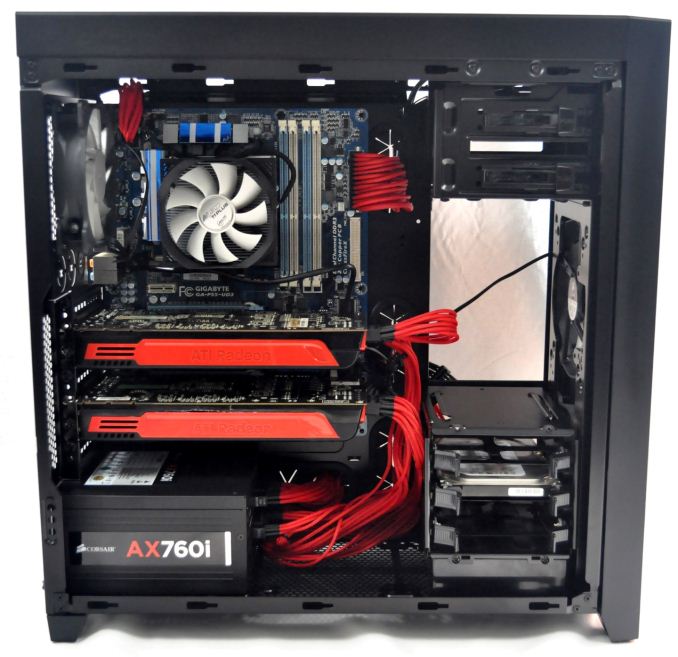Corsair Obsidian 450D Case Review
by E. Fylladitakis on April 4, 2014 6:00 AM EST- Posted in
- Cases/Cooling/PSUs
- Corsair
- mid-tower
- Case
Final Words
With the Obsidian 450D, Corsair attempted to fill the gap between the Micro-ATX 350D and the very large 750D of the same series with a mid-tower case of normal proportions. Yes, they already have half a dozen mid-tower cases available, such as the Graphite 230T and the Carbide 300R, but only the 650D / 550D are part of the Obsidian series and they have been engineered with entirely different target groups in mind. The Obsidian 450D is a normal sized mid-tower case designed to deliver flexibility and cooling for a reasonable retail price. Considering the variety of cooling options that may be applied and the additional flexibility that the removable drive cage offers, the Obsidian 450D does very well in terms of versatility, within the boundaries of a mid-tower design of course.
The thermal performance of the Obsidian 450D definitely is to be reckoned. Even with the slow-spinning stock fans, the heavily perforated chassis of the Obsidian 450D allows heat to escape towards virtually all directions if required. As such, the thermal performance of the Obsidian 450D is unusually high for a mid-tower ATX design. On the other hand, these many openings have the exact opposite effect when it comes to noise suppression; they do nothing to stop noise from exiting the chassis.
The stock cooling of the Obsidian 450D is very good in terms of acoustics performance, with the fans being only slightly audible even while running at maximum speed; however, although the noise figures are very low for a case with so many openings, even with the fans running at maximum speed, the noise of everything installed inside the Obsidian 450D (e.g. GPUs, CPU coolers, etc.) will not be damped in the slightest. Corsair obviously did not design Obsidian 450D with minimal noise operation in mind; it wouldn't make much sense to do so either, as they already had the Obsidian 550D available for that purpose.
In terms of design, the Obsidian series consists of Corsair's most serious and elegant products. They have not been created so as to stand out via an aggressive appearance or strong lighting; the Obsidian series cases lure the attention of spectators through their clean, refined design. The post-minimalistic design of the 450D is undoubtedly a perfect match for the Obsidian series. Uniqueness however is an entirely different story; the Obsidian 450D is essentially a larger 350D or smaller 750D, as all three of these cases share the same design. Even the cubic 250D and the massive 900D share a similar core design, with the distinguishable dissimilarities being due to their much different shape. If the 450D had no perforated front intake cover, it could be easily mistaken for a 350D, even though the latter is significantly shorter.
The MSRP of $119 is reasonable for an Obsidian series case, especially considering that the similarly sized 650D retails for nearly twice the price. However, there are multitudes of similarly sized and less expensive products available, some of which offer the Obsidian 450D strong competition. Even Corsair's own products, such as the Carbide 500R and 300R, are possible opponents for the Obsidian 450D, as they too offer good cooling options and versatility. We however believe that the strongest feature of the Obsidian 450D is its graceful, clean appearance, which will surely attract a significant number of consumers all by itself.
In summary, the Obsidian 450D delivers great cooling performance and a clean aesthetic at a moderately high price. Those who have eyed the Obsidian 350D in the past and wanted something a bit larger (but not as large as the 650D) will be pleased with what it offers. Corsair continues to make cases that are easy to work with and have all the necessary features, and the 450D is no exception. While it's not the best fit for a low-noise solution, enthusiasts and gamers will have plenty to work with.












36 Comments
View All Comments
Larry Endomorph - Friday, April 4, 2014 - link
Nice review. But, ...Your line charts are useless for color blind people.
Add tick marks to the lines. Something like this:
http://www.excel-easy.com/examples/images/line-cha...
E.Fyll - Friday, April 4, 2014 - link
I am sorry, I cannot simply do that, the data points are far too many. I will see if I can do something about it though.Larry Endomorph - Friday, April 4, 2014 - link
Thanks.Another idea:
http://amplusmarketing.com/sites/all/themes/amplus...
The_Assimilator - Friday, April 4, 2014 - link
Sooo... it's basically a Fractal Design Arc Midi R2, with fewer hard drive trays and hard drive cage positioning options, more plastic, and a slightly different look... and the Arc Midi is $20 cheaper.Yeah, no.
The_Assimilator - Friday, April 4, 2014 - link
Oh... and the Arc Midi comes with a built-in 3-channel fan controller. Try harder, Corsair.NeatOman - Friday, April 4, 2014 - link
I like my Lian-Li PC-7HXW better, i picked it up for $90. I just inverted the side window.. it was very ugly on the outside IMOEnzoFX - Friday, April 4, 2014 - link
The proportion to cases that are useless to me, to ones I would consider for future builds here at Anandtech is retarded. How about more ITX cases?Razorbak86 - Friday, April 4, 2014 - link
"Retarded"? Seriously? Are you 12 years old?The_Assimilator - Saturday, April 5, 2014 - link
How about: no.FriendlyUser - Saturday, April 5, 2014 - link
You live in a closet and can't afford the space for a midi tower?